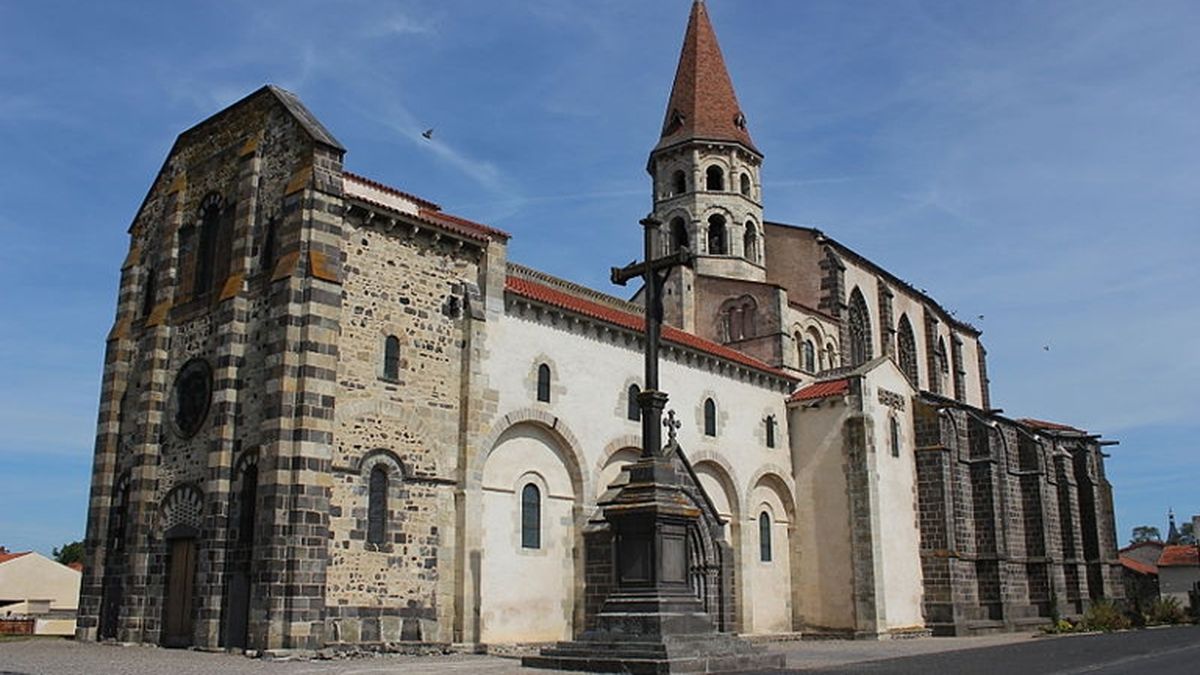 The church | ©Devisme.alain / CC-BY-SA
The church | ©Devisme.alain / CC-BY-SAThe swamps’ cathedral
White hairs and lava stone
Hear ye, hear ye… Once upon a time where counts of Auvergne found the grass was greener, in Ennezat…
One of them, Guillaume III, an old men with white hairs (he was nicknamed ″Tow’s Face″) decided to raise a luxurious palace, here, in the 10th century...
His successor, Guillaume IV, turned up and founded a nice Romanesque collegiate church made of Volvic stone for the Gothic parts.
12 cannons settled: they had to clean the area, to empty all the surrounding stinky swamps… ugh! Besides, our church was nicknamed… ″the swamps’ cathedral″!
On the road again
By the way… the church was dedicated to saint Victor and sainte Couronne, two martyrs especially worshiped in Compostela.
Maybe that was why in Ennezat, pilgrims used to make a stop on the long road towards Spain?
Fortifying the place
Anyway, all the kings and princes of that time gave lot of money to the new collegiate church!
Later, cannons altered it but kept the Romanesque nave, the transept and the choir. And when wars of Religion came, they fortified the church, in 1576: a good protection against Protestants!
The visit of Ennezat
So, our church has two different part: the first one, Gothic (chapels, choir) in black lava stone and the second one, Romanesque (nave, transept, aisles) made of white stone: a nice mix, typical of that part of Auvergne!
Shoo, in hell!
Hey, look! Do you see these two capitals in the transept?
Don’t miss the one representing the miser’s soul (11th c.): oh, you’ll recognize him, he’s wearing a purse around his neck and there’s a treasure at his feet.
Two demons hold him prisoner. And the Devil speaks. He says: CANDO VSURAM ACEPISTI OPERA MEA FECISTI (″You were a miser, now, you have to act according to my order″)
Naughty modillions!
Famous historian Prosper Mérimée was pretty shocked after his visit in Ennezat.
Well, those modillions were pretty… indecent! And yet he wasn’t prude! Do you know what are modillions? Blocks of carved stone put under cornices, to support them, typical of the Romanesque style.
Sculptors carved monsters and bawdy scenes on them!
So, these two modillions are women showing us their back, and a tonsured monk, sitting, with a naked woman hugging him.
He’s going to have a jolly good time! Em! Prosper hesitated: ″Is there an allusion to a depraved monk discovering lust, or a piece of mischief from the sculptor?″
Dead... or alive
Here, we can see a nice wall painting from the 15th century.
First, a fresco about the story of the trois Morts et des trois Vifs (″The 3 Dead and the 3 Living″), a very famous tale from the Middle Ages!
Ooo, you probably heard about it: 3 skeletons are in front of 3 lords. The moral? Kings like simple chaps, we will all die one day, life is only futility...
Damned women!
Hey, wait for the second fresco! About the Last Judgment: on one side, we can see the chosen led by angels in Heaven, and the damned on the other side. The damned ones are only… women!
And below, do you see that? An angel looking at a cadaver. A banner in the dead man’s hand says: Prya pour moi qui me reguardes Quar tyel seras quat que tu tardes Fais bien tandis que tu vis Quar après la mort n'auras nulz amis. (″Pray for me, because soon you’ll be like me, dead. And in the next world, you’ll be alone″).
The angel answers: Reguarda la graid pityé de nature humayne Commet vient à destruccion et forma vilayne. (″Look at us, poor human being, who soon will turn into dust″)
